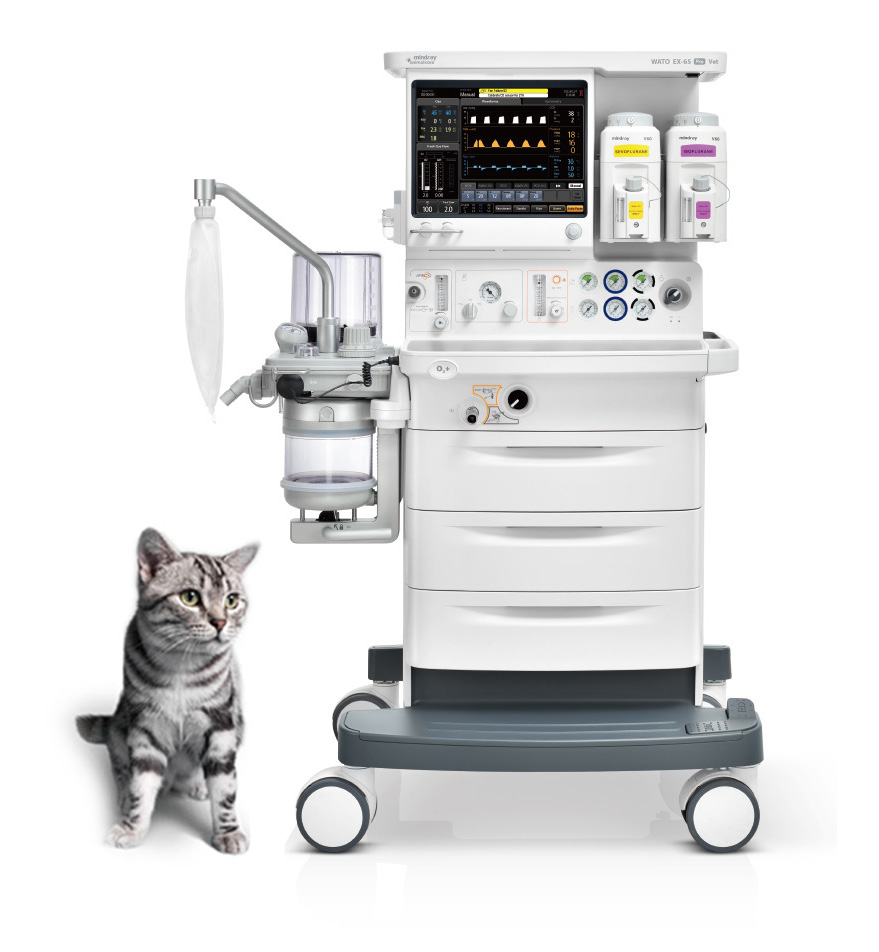High-end Veterinary Anesthesia Machine
WATO EX-65 Pro Vet
New
Professional, vet-dedicated


Enhanced Performance
115-inch Touchscreen with Intuitive UI
With a high resolution 15-inch capacitive touchscreen, users are able to view and adjust parameters as needed. The intuitive layout and simple flat-menu structure ensure all parameters are clearly displayed and only two steps are required to set the ventilation mode.

2Precise Electronic Flow Meters
The digital gas mixer makes fresh gas flow settings easier and more precise. Virtual high- and low-flowmeters are shown separately, more accurately representing lower flow rates. Users can choose either total flow control mode or direct flow control mode out of different habits.

Optimizer: The Optimizer calculates minimum patient O2 requirements and recommends fresh gas flow rates in comparison to current settings. This can reduce environmental pollution, as well as save money by reducing medical gas and anesthetic agent consumption.

AA measurement: The new anesthetic agent calculation software enables users to monitor real-time anesthetic agent consumption.
3Comprehensive Modular Monitoring
Plug-and-Play Multi-Gas modules, with Artema gas monitoring technology, provide comprehensive breath-by-breath analysis of O2, CO2, N2O and auto-detection of five anesthetic agents.


Comprehensive Ventilation Modes
A full range of ventilation modes to meet clinical requirements for various patients, enabling precise ventilation for critical cases.

Lung Recruitment
- Lung recruitment helps to:
- Reopen collapsed alveoli
- Promote more efficient gas exchange
- Prevent respiratory complications
- Two maneuvers: one-step (sustained inflation) or multi-step (incremental PEEP). Quick start or stop with single button.
- Multiple criteria to evaluate recruitment effectiveness.

IT Solution Improves Efficiency
- Data from the WATO EX-65 Pro Vet can be transmitted to the BeneVision CMS Vet through the ePM 12M Vet patient monitor.
- Anesthesia information synchronizes between anesthesia machines and patient monitors. Integrated data and electronic record reduces staff workload and improves efficiency.
- Provides a stable and advanced information interconnection solution to improve anesthesia and operating room management.

Veterinary Dedicated
Wide Tidal Volume Range
The minimum tidal volume can be as low as 5 ml in VCV, PCV-VG, and SIMV-VG modes, avoiding lung barotrauma in small-size animals. Tidal volumes from 5 ml to 1500 ml, and everything in between, are suitable for a wide range of patients, from 0.5 kg up to 150 kg.

Optimized Alarm Trigger Mechanism
Powerful algorithm technology from Mindray Animal Medical reduces the false apnea alarm which usually happens when the patient is small and the tidal volume is low. Reduces the alarm fatigue and provides a comfortable OR for staff.

Autoscaling Waveform
The waveform graphs are automatically scaled according to measured values. When values are low, such as flow rates and volumes for smaller patients, the system adjusts the scale to more appropriately and intuitively represent the patient's waveforms and spirometry.

Before Autoscaling

After Autoscaling